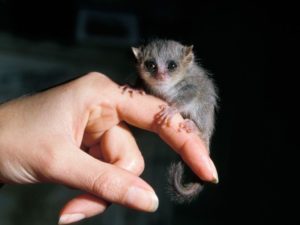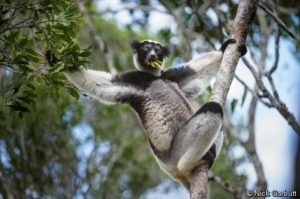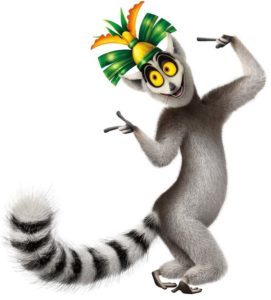Podcast: Play in new window | Download (Duration: 13:56 — 10.8MB)
I swear I didn’t make up the word tratratratra! It’s a real word for an animal that was probably real, although it may be extinct now. Let’s learn about this Lemur of Mystery and some of its friends!
A mouse lemur:

An indri:

King Julian:

Further reading:
The Search for the Last Undiscovered Animals by Karl P.N. Shuker
Show transcript:
Welcome to Strange Animals Podcast. I’m your host, Kate Shaw.
This week we’re looking at an animal with a name I swear I’m not making up, the tratratratra. Seriously, it’s a real name. The animal itself…well, we’re not exactly sure.
Tratratratra is the name of an animal that was supposedly common in Madagascar when the Malagasy people settled there around 2000 years ago. It was described as a lemur about the size of a calf with a human face but hands more like a monkey’s. Supposedly it still lives on Madagascar in remote, hard-to-reach areas.
Madagascar is a big island off the coast of East Africa, with smaller islands around it. It has been isolated from both Africa and Asia for 88 million years, so many of its plants and animals are found nowhere else on earth. Lemurs are one example. There are over 100 known species and subspecies of lemur on Madagascar, but lemurs are found nowhere else in the world. Even more species of lemur have gone extinct since humans settled on the island, including one that might be the tratratratra.
First of all, what’s a lemur? If you’ve seen the movie Madagascar, you have a pretty good idea of what a lemur looks like, although you may overestimate the amount of dancing they do.
Technically the lemur is a primate, although it doesn’t look much like other primates at first glance. Different species can look radically different, of course, but in general they’re long-bodied animals with long tails and monkey-like hands and feet with nails instead of claws. They’re mostly social animals who eat plants and fruit, although some eat insects, arthropods, and other small animals. Most lemur societies are female-led. All are endangered due to habitat loss, poaching, and the illegal pet trade.
While we tend to think of apes and monkeys when we hear the word primate, the primate order contains many other types of animal. Lemurs belong to the Strepsirrhini suborder, which includes bushbabies, pottos, and lorises. Apes and monkeys belong to the Haplorhini suborder, along with tarsiers. Researchers think that the ancestors of lemurs migrated to Madagascar from Africa about 50 million years ago on rafts of vegetation. This sounds ridiculous since Madagascar is more than 300 miles, or 500 km, away from Africa at its closest point, and the prevailing winds and ocean currents push floating logs and other vegetation away from the island. But 60 million years ago the currents flowed the other way. By 20 million years ago, continental drift had pushed Africa and Madagascar farther north so that the currents changed to what they are now, which helped isolate the island even further.
The smallest lemur species is the mouse lemur, which is only 11 inches long including its tail, or 27 cm. The largest is the indri, which is a black and white animal with long legs but no tail, which grows to almost 2 ½ feet long, or 72 cm. In other words, even the biggest lemur alive today isn’t all that big. But that didn’t used to be the case.
When humans first settled on the island, there were three kinds of giant lemurs. Let’s take a quick look at them.
Monkey lemurs went extinct around 1500 years ago and probably spent most of their time on the ground. They weren’t huge, probably not any bigger than the indri. We don’t have very many monkey lemur remains so we don’t know much about it, but researchers think it primarily ate seeds, although it might have also eaten grass and leaves. Its limbs were short and powerful with short hands and feet. It had a heavy skull with big molars for grinding plant material. It probably went extinct mostly due to competition with introduced livestock like pigs.
Koala lemurs were bigger than the indri, up to five feet long, or 1.5 meters, and went extinct around 1000 years ago. Incidentally, one thousand years ago there was a terrible drought in Madagascar that caused crops to fail, lakes to dry up, and wildfires to start, and which contributed to many species going extinct. Anyway, the koala lemur was shaped more like a koala than a lemur. It lived its whole life in treetops, eating leaves, and it had some weird features for a primate. Its eyes were on the sides of its head like a rabbit’s or a horse’s, instead of in the front of its head like all other primates. Its snout was long and tapered, but it had a big nasal area that probably indicates an enlarged upper lip, maybe even partially prehensile, that helped it gather leaves. It was also heavier than all other lemurs, and some of the remains we have show evidence that they were butchered by humans to eat.
Finally, sloth lemurs probably ate plants, fruit, and nuts, and some species may have hung from branches the way sloths do. Instead of big claws for climbing, sloth lemurs had long fingers. There were a number of species, so let’s look at a few of them. Don’t worry, we’re getting closer and closer to the tratratratra.
Archaeoindris was the biggest lemur that we know of. It was the size of a gorilla, maybe even a little bigger, which would make it one of the largest primates that ever lived. Its skull was large and heavy, and it probably ate leaves. It may have occasionally climbed trees but probably spent most of its time on the ground. We don’t have any hand or feet bones so we don’t know if it had adaptations for climbing trees or for walking on the ground. It was already rare when humans first came to Madagascar and went extinct shortly afterwards.
Now we’re up to Palaeopropithecus ingens, and this may be our tratratratra. It wasn’t as big as Archaeoindris but it was still much bigger and heavier than the modern indri. It ate leaves, nuts, and seeds and probably spent a lot of time in the trees. Its arms and legs were powerful and it had long fingers and toes, which it used to hang from branches like a sloth. It had other adaptations, like curved arm and leg bones, that shows it was adept at climbing on, hanging from, and brachiating through tree branches. Even the hands were curved, so that the fingers were more like hooks. But it probably wasn’t a very fast mover, so was easily hunted by humans and would have provided a lot of meat.
According to Admiral Etienne de Flacourt in his 1658 history of Madagascar, the tratratratra is “a large animal like a calf of two years old, with a round head and the face of a man: the fore feet are like a monkey (or ape), and the hind feet also. It has curly or frizzy hair, a short tail and ears like those of a man. It resembles the ‘tanacht’ described by Ambroise Paré. It can be seen near the pond of the Lipomami tribe and in that region is where it can be found. It is a highly solitary animal, the people of that country have a great fear of it and flee from it as it also does from them.”
I got that quote from an article in Volume 15 of Lemur News, from 2010. I’ll put a link in the show notes for anyone who’s interested in lemurs, because it has lots of interesting information.
Palaeopropithecus ingens probably had a short tail like the still-living indri, which is a close relative. It probably also had rounded ears like the indri. And like the indri also, it may have had wavy or curly hair.
The tratratratra’s name probably came from its call, which might have been an alarm bark or a chattering sound. Many local lemur names do come from the animals’ calls. Some researchers consider the tratratratra’s name to be a fossil sound, and one of the very few we have.
We don’t know exactly when Palaeopropithecus went extinct. It might have been as recently as four hundred years ago, maybe even more recently. There have only been a few modern-day sightings of an animal that might be the tratratratra. A French forester in the 1930s saw what he claimed was a gorilla-like lemur with a human-like face, four feet tall, but that’s about it. So whatever the tratratratra might be, it’s probably extinct by now. But maybe it’s hanging on in the forested hills north of Tulear, where the last fragments of Madagascar’s original forests remain.
There is an interesting Malagasy tradition reported in 2003 about an ogre with the face of a human, which was helpless on smooth rocks. Since Palaeopropithecus was so well adapted to living in trees, like modern sloths it probably couldn’t walk on the ground very well. So even if the tratratratra is extinct, its memory lives on in modern culture.
The tratratratra isn’t the only mystery lemur in Madagascar. The kidoky is supposed to be a big lemur with dark fur but a couple of white spots on its face. It has a rounded face, a loud whooping call, and spends at least part of the time on the ground. When it runs, its gait is more like a baboon’s than a lemur’s.
Some people think the kidoky might be one of the giant lemur species that are supposedly extinct. Zoologist Karl Shuker suggests Archaeolemur or Hadropithecus as possible identities, both of which spent a lot of time on the ground. In fact, they resemble baboons in so many ways that they’re both known as baboon lemurs. But Hadropithecus went extinct around 1200 years ago and Archaeolemur around 800 years ago, as far as we know. But an ethnographic survey published in 1998 reports one native villager who saw a kidoky in 1952 at close range.
The tokandia is another mystery lemur, this one even bigger than the kidoky—as big as a bear. Not that they have bears in Madagascar. It’s supposed to live mostly on the ground but sometimes it would jump up into trees. It didn’t look like a human but its calls sounded like they were made with a human voice. Again, Shuker suggests it might be a koala lemur, specifically Megaladapis edwardsi—you know, the one that could grow five feet long, or 1.5 meters.
The kalanoro is a more human-like creature from folklore, usually described as a small person who steals food. Some stories say it lives in the water. If it’s based on a real animal and isn’t just the Malagasy version of little folk common throughout the world’s cultures, it might be based on a type of lemur.
One last note. In the quote earlier about the tratratratra, de Flacourt mentions an animal called the tanacht. Is it another type of lemur? Is there no end to lemur mysteries?
It’s not a lemur, no. A French priest called Father André Thévet wrote about the tanacht in 1575, but he said it lived in India. It was supposedly the size and roughly the shape of a tiger, but it didn’t have a tail, and it did have the face and hands of a human with a snub nose. It might have been a species of Asian colobine monkey such as the pig-tailed langur, which can have orangey or golden fur and only has a short tail, or it might have been a stump-tailed macaque, which has pale brown fur and no tail. But neither of those monkeys are anywhere near as big as a tiger, so who knows what the tanacht might actually be?
But for now, I’m primated out, so check back next week for an episode that’s not about primates!
You can find Strange Animals Podcast online at strangeanimalspodcast.com. We’re on Twitter at strangebeasties and have a facebook page at facebook.com/strangeanimalspodcast. If you have questions, comments, or suggestions for future episodes, email us at strangeanimalspodcast@gmail.com. If you like the podcast and want to help us out, leave us a rating and review on Apple Podcasts or whatever platform you listen on. We also have a Patreon if you’d like to support us that way.
Thanks for listening!